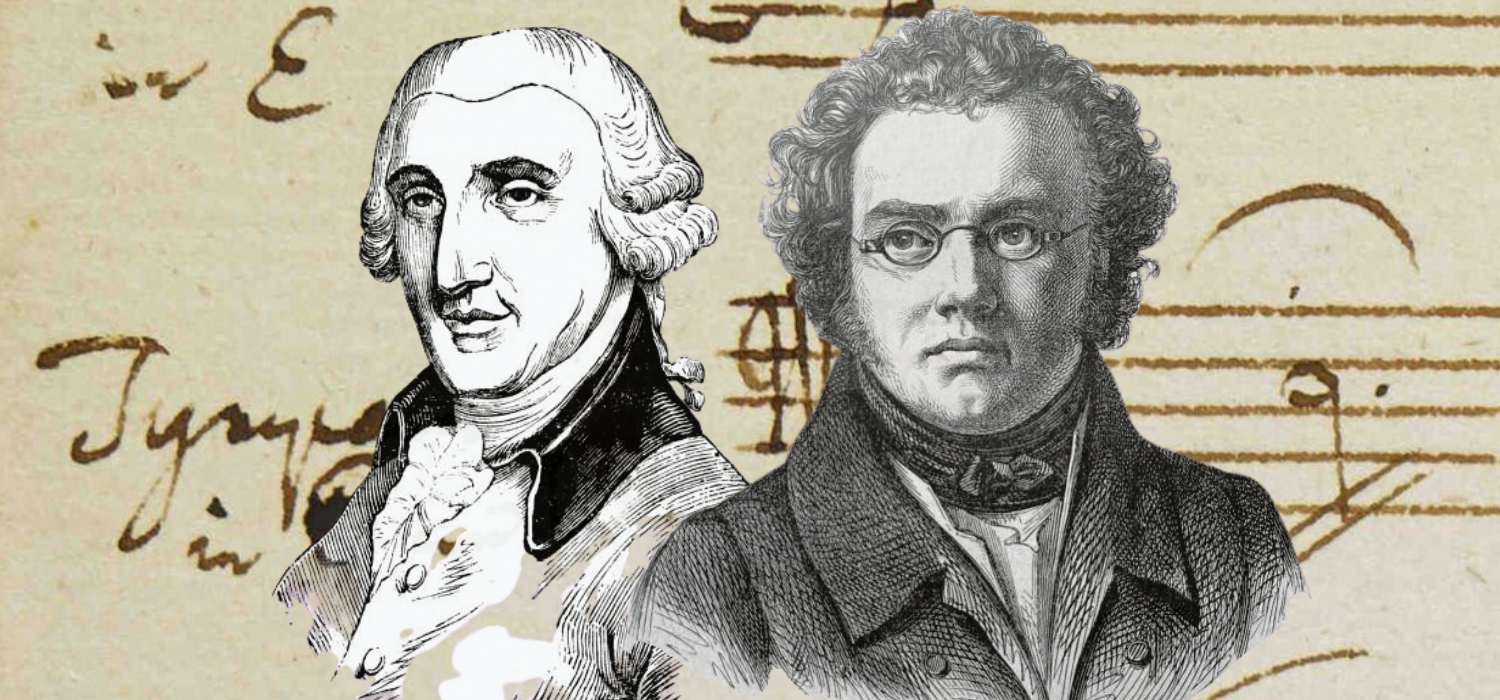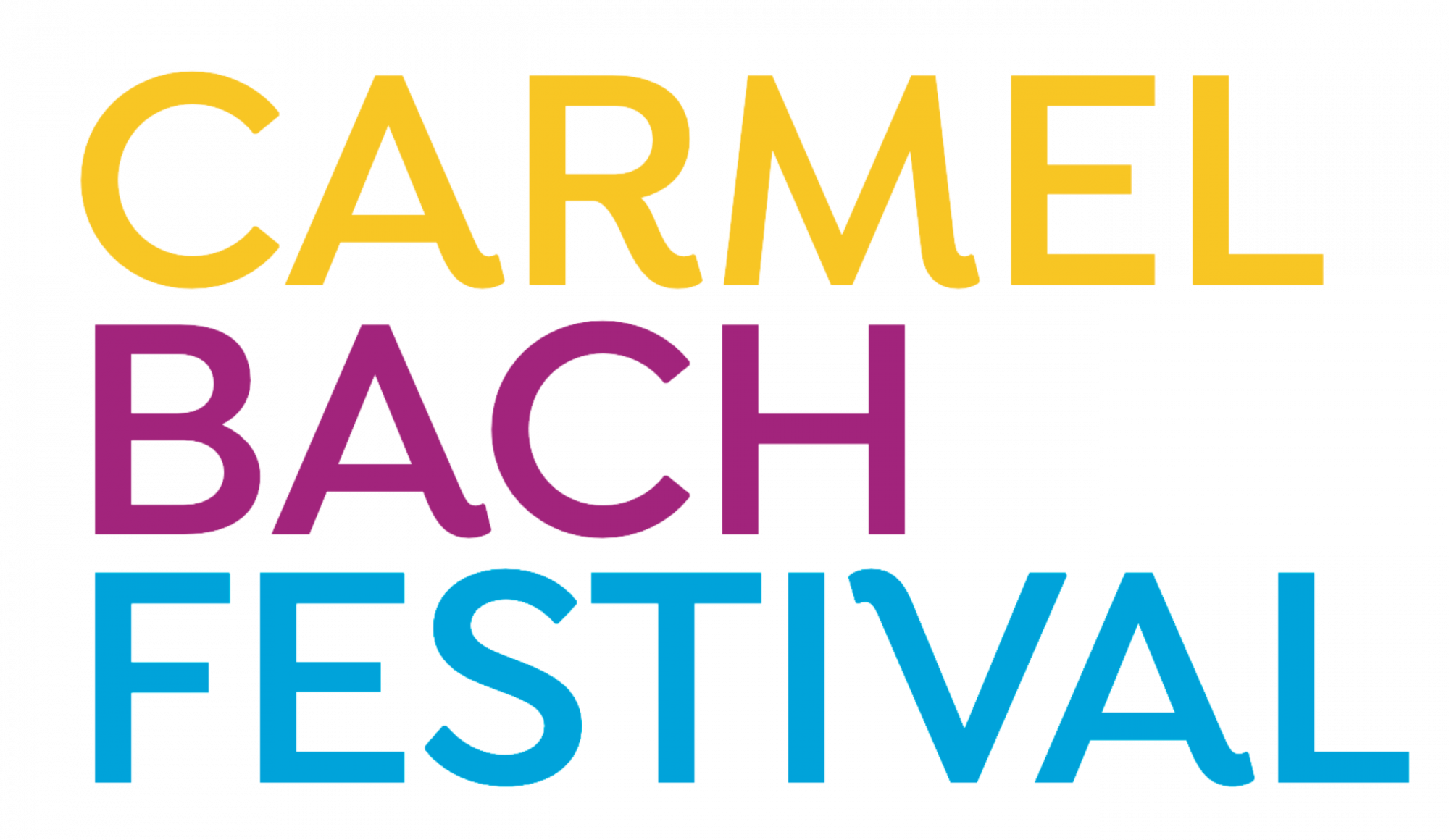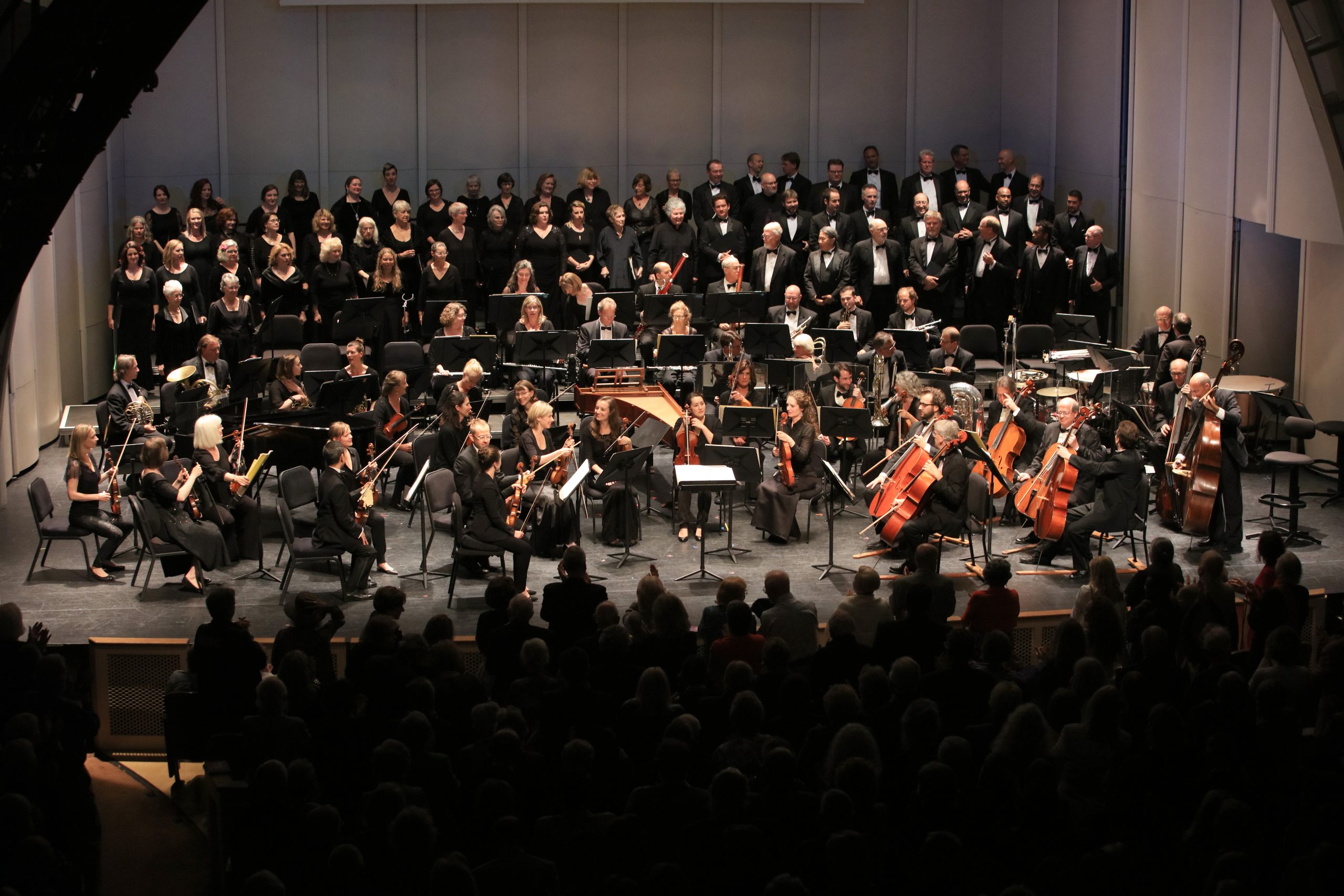
Haydn and Schubert
Thursday, July 28, 7:30 PM
Artists: Festival Orchestra conducted by Nicholas McGegan
| JOHANN SEBASTIAN BACH | Ricercare No. 2 from Musical Offering, BWV 1079 | |
| (1685–1750) | ||
| orchestrated by ANTON WEBERN | ||
| (1883 –1945) | ||
| FRANZ JOSEPH HAYDN | Symphony No. 103 in Eb Major, Hob.I/103, (”Drum Roll”) | |
| (1732 –1809) | 1. Adagio – Allegro con spirito | |
| 2. Andante più tosto allegretto | ||
| 3. Menuet | ||
| 4. Allegro con spirito | ||
| FRANZ SCHUBERT | Symphony No. 8 in B Minor, D. 759[1], (”Unfinished”) | |
| (1797 –1828) | 1. Allegro moderato | |
| 2. Andante con moto | ||
Ricercare No. 2
Imagine a typical musical evening at Frederick the Great’s palace in Potsdam. His Royal Highness, at present not waging war, is ready with his flute to play one of several hundred concertos by his Kapellmeister and flute teacher J.J. Quantz, or perhaps a work of his own composition, or both. His harpsichordist C.P.E. Bach, whose music he does not care for, dutifully sits at the keyboard and the other musicians, each a master of his instrument and hailing from all over Europe, stand at the ready. But on a particular evening in the spring of 1747, the king first looks over the list of new arrivals at the city gate and suddenly announces, “Old Bach is here.” As the local press reported, “The King immediately gave orders for Bach to be admitted and went, at his entrance, to the pianoforte…condescending to play, in person and without any preparation, a theme on which to improvise a fugue. This the Kapellmeister did so successfully that not only was His Majesty pleased…but all those present were seized with astonishment.”
Frederick went further, requesting that Bach improvise a six-part (!) fugue on the spot, which he deferred until producing the written version weeks later in Leipzig. The result of this gauntlet- thrown by the king and the proud response of a genius at the top of his form is this collection comprising the Musical Offering: ten canons, two fugues, and a four-movement trio sonata, all incorporating, in varying degrees of subtlety, the Royal theme. The term Ricercare as used here is synonymous with fugue, and Bach may have chosen it because of the acronym Regis Iussu Cantio Et Reliqua Canonica Arte Resoluta (At the King’s command the theme and the remaining pieces worked out with canonic art). The Ricercare a 2 was too complex for even Bach to improvise in the moment, but was the result of his usual care and deep reflection. It is sometimes played on the harpsichord alone, sometimes with several diverse instruments intended to make the different parts more distinct. Anton Webern arranged it, in his cryptic style, for full orchestra in the early twentieth century. Tonight’s performance with string orchestra offers the chance to hear the complexities of this work of genius illuminated in yet another way.
– Allen Whear
Symphony in E-flat Major, Hob. I:103 (“Drum Roll”)
“l am Salomon from London and have come to fetch you.” These words changed Haydn’s life. London-based violinist/impresario Johann Peter Salomon had been trying for years to lure Haydn to London. Upon hearing that Prince Nikolaus Esterházy had died and Kapellmeister Haydn was a free agent after three decades in Esterházy service, Salomon headed straight to Vienna and showed up on Haydn’s doorstep unannounced. He must have been persuasive. Solomon and Haydn arrived in Dover on New Year’s Day, 1791. During the next 18 months, Haydn’s status leapt from provincial Kapellmeister to international celebrity. He was soon the idol of an adoring public and found himself dining with the Prince of Wales and the Duke of York. None of this went to Haydn’s head. King George III coaxed him to remain in England and the Queen offered him a suite in Windsor Castle, but Haydn preferred to be his own man. He returned to Vienna in June 1792 with a handsome profit and an honorary doctorate from Oxford.
He composed the Symphony in E-flat Major (“Drum Roll”) during his second trip to London and conducted the premiere at the King’s Theatre on March 2, 1795. London audiences knew by now to expect the unexpected from Haydn. They didn’t have to wait long. A long timpani roll brings everyone to attention right at the outset. Then comes a slow, solemn incantation by bassoon and low strings. The Allegro’s spirited opening breaks the spell and a waltz theme further along dispels any memory of the opening gloom, but just as we think the movement’s almost over, the strings break into a fit of shivery agitation, hinting that something unusual is about to happen. It does. The spectral opening music — drum roll and all — appears unannounced, but is quickly ushered out the door. The Andante features two themes based on folk melodies and two variations on each theme. The Trio* following the Minuet* is an elegant balancing act between woodwinds — two solo clarinets and bassoon — and strings. A prominent horn call announces the finale. This splendid movement glides along with a sense of ease that belies its contrapuntal underpinnings and builds to a glorious climax.
— Jean Widaman
Symphony No. 8 in B Minor, D. 759 (“Unfinished”)
Franz Schubert’s short life roughly coincided with that of Beethoven’s—both passing away within about a year of each other. But what a difference there is between the life and music of these two giants of early romantic music!
Beethoven — world renowned with fiery temperament, and master of struggling to hammer out profundities from modest ideas — strode across the musical landscape of Europe as a conqueror. Schubert, on the other hand, lived quietly within a circle of close friends, rarely capturing the public’s imagination,
while turning out an immeasurable wealth of melodies, apparently with little effort. In his brief career Schubert composed orchestral music, dabbled in opera, produced masterpieces of chamber music, and created a significant body of compositions for piano. But his glory, and the world’s musical treasure, lies in his Lieder (German songs). It is astounding that he composed more than 600 of them, and they constitute the defining repertory within that genre. No one else — not Schumann, Brahms, Wolf, Strauss, nor Mahler — come close to the defining mark of Schubert. Almost single handedly he created the first masterpieces of German song, and so many, at that. They are constituted of marvelously imaginative piano accompaniments (which are really equal in importance to the vocal part); innovative harmonies; poetic texts of high artist quality; and an unprecedented gift for an endless variety of exquisite melodies. And it is an understanding and appreciation of the centrality of song in Schubert’s oeuvre that informs our encounter with his instrumental music, including his symphonies.
He wrote nine symphonies, but two of them have garnered the most prominence: The “Great C Major” symphony and the “Unfinished.” Many have claimed that the latter really is “finished,” (owing to its genius), and many others have actually finished it (Fools rush in . . .) by composing the missing last two movements in Schubert’s style. But, manifestly it is unfinished, but of such gripping quality and beauty that it really doesn’t matter. Ironically, it did not meet the light of day (literally) until 1865, when it was retrieved, almost as an afterthought, from an obscure personality’s desk drawer. Schubert never heard any of his symphonies played by a professional orchestra, and none of them were published in his lifetime. Yet, here is an iconic work of early Romanticism that lay undisturbed almost from the time of its composition in 1822. In many respects it manifests most of the technical characteristics (and I won’t bother you with those) of late Classical symphonies such as those of late Haydn and Mozart, and perhaps early Beethoven. The essence of this great work is more elusive: its dark and reflective tone, its stunning and novel combinations of subtle instrumental color, the characteristic and striking harmonic language — and, of course, the Schubertian melodies. Technical points pale beside these qualities — the “Unfinished” opens a new atmospheric sound world of Romanticism that is palpable beyond analysis.
—Wm. E. Runyan © 2015 Wm. E. Runyan
In his six decades on the podium, Nic McGegan—long hailed as “one of the finest baroque conductors of his generation” (The Independent) and “an expert in 18th-century style” (The New Yorker)—served as Music Director of Philharmonia Baroque Orchestra and Chorale for 34 years, and Artistic Director and conductor at Germany’s Göttingen Handel Festival for 20 years.
As a guest conductor, he has appeared with the New York, Los Angeles, and Hong Kong Philharmonics; the Chicago, Dallas, and Toronto Symphonies; the Philadelphia Orchestra; Scottish Chamber Orchestra; and the Amsterdam Concertgebouw among others.
McGegan’s prolific discography includes more than 100 releases spanning five decades, including 20 albums recorded with Hungary’s Capella Savaria on the Hungaroton label and two recent albums with the Swedish Chamber Orchestra under the BIS label. His extensive discography with Philharmonia Baroque includes two Grammy nominees.
McGegan is committed to the next generation of musicians, frequently conducting and coaching students in residencies and engagements at Yale University, the Juilliard School, Harvard University, and the Colburn School. He was awarded the honorary degree of Doctor of Music by the San Francisco Conservatory of Music and an honorary professorship at Georg-August University, Göttingen. He was made an Officer of the Most Excellent Order of the British Empire (OBE) “for services to music overseas.” English-born, McGegan was educated at Cambridge and Oxford.


